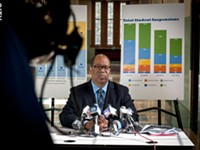Friday, April 12, 2013
Rochester's education, housing, and poverty by the numbers
Posted By Tim Louis Macaluso on Fri, Apr 12, 2013 at 9:56 AM
If you’ve lived in the Rochester region for a few years, the scores on ACT Rochester’s recently released annual Community Report Card probably won’t shock you. Most of us already know that the nine-county Rochester region, overall, is doing better than the state in some areas — the economy, education, health, and housing.
But when the report focuses on the city, however, it exposes stark disparities involving race and ethnicity. And correlations between different sets of data become more evident.
One of the most obvious is the relationship between educational outcomes in city schools and housing.
For example, third grade English Language Arts scores on state tests show that 61 percent of white students in the region are proficient at reading and writing, compared to 34 percent of white students in city schools.
But only 35 percent of African American third graders in the region are proficient at reading and only 23 percent from city schools.
The problem gets worse as the students age, with 60 percent of eighth-grade white students in the region proficient in reading and writing and 35 percent in city schools.
But just 26 percent of African American eighth graders in the region are proficient and 15 percent in city schools.
The data, which is drawn from 2011, follows a similar pattern when examining math scores for grades 3 and 8.
But how does this relate to adults?
The Report Card does not track students to adulthood, but an interesting thing happens when you look at a comparison of rent as a percent of income by race and ethnicity.
About 12 percent of a white person’s income goes to rent in the Rochester region, and about 34 percent of their income goes to rent in the city.
But African Americans struggle, with 45 percent of their income going to rent for those living in the region. And 49 percent of their income goes to rent if they live in the city.
The federal guidelines for housing say that housing costs should not exceed 30 percent of a person’s income, regardless of whether it’s rent or a mortgage. The data, which was collected from 2006 to 2011, indicates a need for more affordable housing, especially in downtown Rochester and Monroe County.
But it’s also a future indicator: many of today’s lower-achieving city students will likely become tomorrow’s lower wage earners struggling to find affordable housing. And if the data does nothing else, it shows just how deeply embedded the concentration of poverty is in Rochester, and how long it will take to address it.
Speaking of...
-

More kids are going to charter schools, but are they better?
Jan 29, 2021 -

Data shows African Americans, Latinos continue to be underserved in Rochester region
Aug 21, 2020 -

Urban Action 8/14
Aug 14, 2019 - More »
Latest in News Blog
More by Tim Louis Macaluso
-

RCSD financial crisis builds
Sep 23, 2019 -

RCSD facing spending concerns
Sep 20, 2019 -

Education forum tomorrow night for downtown residents
Sep 17, 2019 - More »

